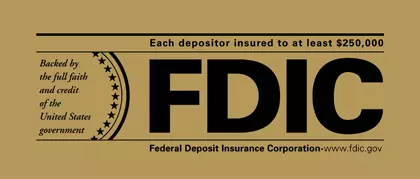The Federal Deposit Insurance Corporation is an independent federal agency created in 1933 to promote public confidence and stability in the nation's banking system.
Throughout its history, the FDIC has provided bank customers with prompt access to their insured deposits whenever an FDIC-insured bank or savings association has failed.
No depositor has ever lost a penny of insured deposits since the FDIC was created in 1933.
The FDIC official sign -- posted at every insured bank and savings association across the country -- is a symbol of confidence for Americans.

Customers know, when they see the FDIC sign, that they will get back all of their insured deposits in the unlikely event their insured bank or savings association should fail.
What is a bank failure?
A bank failure is the closing of a bank by a federal or state banking regulatory agency. Generally, a bank is closed when it is unable to meet its obligations to depositors and others. This brochure deals with the failure of "insured banks." The term "insured bank" means a bank insured by FDIC, including banks chartered by the federal government as well as most banks chartered by the state governments. An insured bank must display an official FDIC sign at each teller window.
What is FDIC's role in a bank failure?
In the event of a bank failure, the FDIC acts in two capacities. First, as the insurer of the bank's deposits, the FDIC pays insurance to the depositors up to the insurance limit. Second, the FDIC, as the "Receiver" of the failed bank, assumes the task of selling/collecting the assets of the failed bank and settling its debts, including claims for deposits in excess of the insured limit.
What is the purpose of FDIC deposit insurance?
The FDIC protects depositors' funds in the unlikely event of the financial failure of their bank or savings institution. FDIC deposit insurance covers the balance of each depositor's account, dollar-for-dollar, up to the insurance limit, including principal and any accrued interest through the date of the insured bank's closing.
What is the FDIC insurance amount?
The standard insurance amount is $250,000 per depositor, per insured bank, for each ownership category. This includes principal and accrued interest and applies to all depositors of an insured bank.
Deposits in separate branches of an insured bank are not separately insured. Deposits in one insured bank are insured separately from deposits in another insured bank.
Deposits maintained in different categories of legal ownership at the same bank can be separately insured. Therefore, it is possible to have deposits of more than $250,000 at one insured bank and still be fully insured. For more information on deposit insurance coverage, see the FDIC's brochure "Your Insured Deposits" which can be accessed at https://www.fdic.gov/resources/deposit-insurance/brochures/insured-deposits/
Who does the FDIC insure?
Any person or entity can have FDIC insurance on a deposit. A depositor does not have to be a citizen, or even a resident of the United States. FDIC insurance only protects depositors, although some depositors may also be creditors or shareholders of an insured bank.
What does FDIC deposit insurance cover?
FDIC insurance covers deposits received at an insured bank. Types of deposit products include checking, NOW, and savings accounts, money market deposit accounts (MMDA), and time deposits such as certificates of deposit (CDs).
What is the source of funding used by the FDIC to pay insured depositors of a failed bank?
The FDIC's deposit insurance fund consists of premiums already paid by insured banks and interest earnings on its investment portfolio of U.S. Treasury securities. No federal or state tax revenues are involved.
How am I notified when my bank has been closed?
The FDIC notifies each depositor in writing using the depositor's address on record with the bank. This notification is mailed immediately after the bank closes.
When the failed bank is acquired by another bank; the assuming bank also notifies the depositors. This notification usually is mailed with the first bank statement after the assumption.
Every effort also is made to inform the public through the news media, town meetings, and notices posted at the bank.
